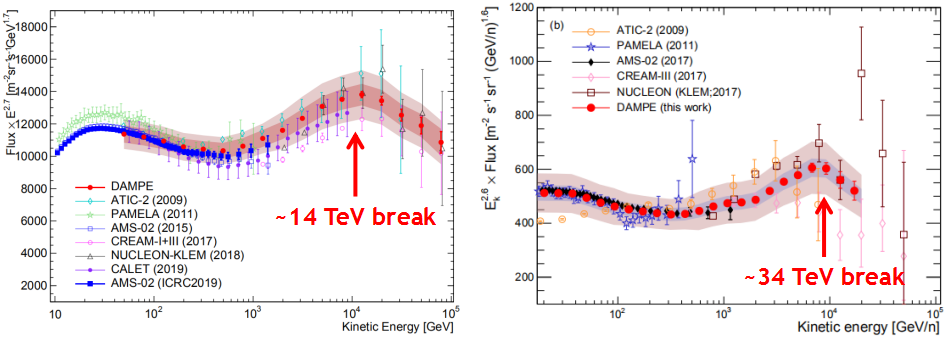Dark Matter Particle Explorer Reports the Most Precise Measurements of Cosmic Ray Proton and Helium Spectra above TeV and Reveals New Spectral Structures
The energy spectrum of CRs, which represents the relation of particle flux to energy, is expected to be a power-law form according to the canonical shock acceleration of particles. Precise measurement of the energy spectrum of CRs is the key to understanding those fundamental questions of cosmic ray physics.
The Dark Matter Particle Explorer (DAMPE), also known as “Wukong”, is a space satellite dedicated to high-energy cosmic ray and gamma-ray observations. Besides probing the nature of dark matter particles, one of the main scientific goals of DAMPE is to precisely measure the energy spectra of cosmic ray particles. DAMPE has an excellent energy resolution (for electrons and gamma-rays), a very good particle identification capability, and a reasonably large acceptance, making it well suitable for the studies of precise spectral structures of cosmic rays.
Protons and helium nuclei, are the most two abundant components of cosmic rays, which account for more than 99% in total cosmic rays. The excellent charge resolution enables DAMPE to have a powerful capability to identify proton and helium, and precisely measure their spectra respectively. Fig. 1 shows the excellent charge measurement of DAMPE at two typical energies.

With the first 30 months on-orbit data, the DAMPE collaboration obtained the precise measurement of the energy spectrum of cosmic ray protons from 40 GeV to 100 TeV energies (DAMPE 2019, Sci. Adv., 5, eaax3793). The DAMPE result shows that the proton spectrum is not compatible with the paradigm of a unique power-law in a wide energy range. Especially, DAMPE newly discovered a spectral “softening” (drop behavior) at about 14 TeV energies. The break energy is expected to be the acceleration limit of a possible nearby cosmic ray source.
On May 18, 2021, the DAMPE collaboration reported the precise measurement of the energy spectrum of cosmic ray helium nuclei from 70 GeV to 80 TeV energies (DAMPE 2021 Phys. Rev. Lett., 126, 201102). The DAMPE result has significantly improved the measurement accuracy of helium spectrum in the energy range above TeV. The spectrum of CR helium shows a very similar TeV structure with the one of CR proton, which suggests a common origin of them. For the first time, DAMPE reveals a softening structure at about 34 TeV energies in the helium spectrum with a high significance (~4.3σ). Together with the softening energy of the DAMPE proton spectrum, the results are consistent with a charge-dependent softening energy of protons and helium nuclei. The common softening is likely an imprint of a nearby cosmic ray source, e.g., a supernova remnant. The softening energy, which is likely Z-dependent for protons and helium nuclei, corresponds to the acceleration upper-limit of such a nearby source.

Since the launch at the end of 2015, the DAMPE detector has been working very stably in-orbit for four years. Significant progresses in the observations of cosmic ray electrons/positions, protons, and helium nuclei have been achieved. With the continuous operation and data collection of DAMPE, it is expected that more and more high-quality data will shed new light on the fundamental questions about cosmic ray physics.
For more detail, please see: http://dx.doi.org/10.1103/PhysRevLett.126.201102.